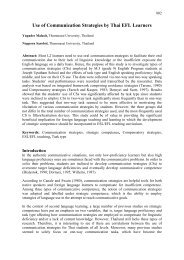Adobe Audition and Stress and Intonation Awareness
Adobe Audition and Stress and Intonation Awareness
Adobe Audition and Stress and Intonation Awareness
Create successful ePaper yourself
Turn your PDF publications into a flip-book with our unique Google optimized e-Paper software.
There were two types of data in this research, qualitative <strong>and</strong> quantitative data.<br />
The qualitative data were collected through observations, photograph taking, <strong>and</strong><br />
interviews. Then, the quantitative data were collected from students’ performance<br />
in the pronunciation class. To analyze the qualitative data, the researcher did data<br />
reduction, data display, <strong>and</strong> conclusion drawing (Miles <strong>and</strong> Huberman, 1994: 10).<br />
The quantitative data were used to support the qualitative data. To get the<br />
quantitative data, the researcher gave a pre-test <strong>and</strong> a post-test to the group of the<br />
students.<br />
The next step of the study was the implementation of the <strong>Adobe</strong> <strong>Audition</strong> 1.5. The<br />
researcher made use of an LCD to show how the sound waves changed <strong>and</strong> also<br />
an active speaker to play the audio. This program allowed the learners to monitor<br />
<strong>and</strong> model how high the intonation is as well as how long the sounds are produced<br />
in a normal speed. Therefore, the researcher could give extra explanation about<br />
how the sounds were produced.<br />
Research Findings <strong>and</strong> Discussion<br />
After conducting the Pronunciation course by utilizing <strong>Adobe</strong> <strong>Audition</strong> 1.5 with<br />
the reference to the planning, implementing, observing, <strong>and</strong> reflecting stages, the<br />
researcher could find some improvement mainly on students’ ability to produce<br />
stress <strong>and</strong> intonation in English <strong>and</strong> also on their attitude toward the pronunciation<br />
course.<br />
Students’ improvement on their ability to produce appropriate English stress <strong>and</strong><br />
intonation could be clearly be seen from the field notes which show that after the<br />
implementation of <strong>Adobe</strong> <strong>Audition</strong> 1.5 on the 1 st meeting, the students realized<br />
that English stress <strong>and</strong> intonation is different from those in their mother tongue<br />
<strong>and</strong> second language. It is shown in the following field note:<br />
“When the teacher showed how stress <strong>and</strong> intonation are used in Javanese<br />
(mother tongue for most of the students) <strong>and</strong> Indonesian (second language)<br />
through <strong>Adobe</strong> <strong>Audition</strong> 1.5 view, especially from the sound waves, the<br />
students started to ask why the sentences have different patterns of sound<br />
waves, especially different peak of sound waves. Getting some explanation<br />
about how the 3 languages use stress <strong>and</strong> intonation, the students realized<br />
that the 3 languages have different consensus about how stress <strong>and</strong><br />
intonation are used in the 3 languages. The teacher then gave more<br />
examples of how English stress <strong>and</strong> intonation are used in real life by<br />
presenting some slides of materials accompanied by their <strong>Adobe</strong> <strong>Audition</strong><br />
1.5 view. ” (field note 013: October 1, 2012 )<br />
Then on the 2 nd meeting, they began to be more careful before they tried to use<br />
stress <strong>and</strong> intonation in reading English sentences, even though it took longer time<br />
for them before they read the sentences given on the slide shows. However, they<br />
became enthusiastic to have the pronunciation activities when the materials were<br />
91






